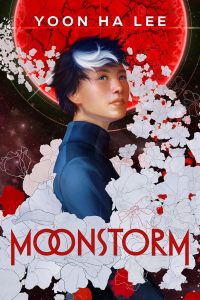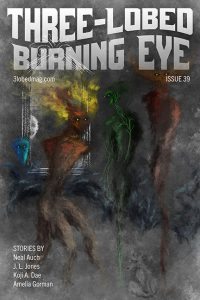Ian Mond Reviews Fever House by Keith Rosson
 Fever House, Keith Rosson (Random House 978-0-59359-575-6, $28.00, 448pp, hc) August 2023.
Fever House, Keith Rosson (Random House 978-0-59359-575-6, $28.00, 448pp, hc) August 2023.
I am a sucker for a great front cover. Emily Temple’s monthly showcase on Literary Hub of the best covers from the preceding four weeks has led me to purchase a book based purely on a striking image or an eye-catching arrangement, regardless of subject matter. Keith Rosson’s fifth novel, Fever House, has a cover deserving of an appearance in Temple’s column. Against a deep orange background, a hand makes the ‘‘devil horns’’ salute, a staple gesture of a million rock concerts. What stands out are the digits, especially the fingers making the horns that taper off into wicked-looking talons. The juxtaposition of demonic horror and rock ’n roll, harking back to the work of John Skipp and Craig Spector, David J. Schow and Jeff Gelb’s series of Shock Rock anthologies, screams: you will have fun with this book! And for the most part, that’s the case; I thoroughly enjoyed Fever House, the novel only let down by a less than satisfactory climax.
The hand isn’t just an awesome image; it’s also central to the plot: one of three remnants, along with the ‘‘voice’’ and the ‘‘eye,’’ imbued with a sickly power. The hand and the voice are the property of ARC, a black ops unit run by the US government. Or at least the hand was. A soldier guarding the remnant is compelled to remove the severed body part from its containment, leaving it in a bathroom on Highway 99. The hand eventually ends up in the freezer of a drug dealer named Wesley, to be discovered by Hutch Holtz, a heavy in the pay of Peach Serrano. Hutch and his partner Tim – suddenly awash with a ‘‘desire to bite and punch, [to] just fall into the red darkness of the thing’’ – take the remnant and Wesley to meet Don Snr, Peach’s second in command. When Wesley tries to bite Don’s face off, and Don responds with a savagery that causes Hutch to lose his lunch, the two heavies know that the hand is the cause. But it’s worse than that. The remnant not only drives a person to horrendous acts of brutality, it also zombifies anyone killed in its presence.
Caught up in this maelstrom of violence is a rogue’s gallery of characters. There’s the aforementioned Hutch, who is fundamentally changed by his contact with the remnant. There’s Nick Coffin, an employee of Peach Serrano (he finds collectibles for his boss) whose brief ownership of the hand draws the attention of ARC, putting his life in danger. There’s his mother, Katherine Moriarty, an agoraphobic who, when she was younger, was lead singer and cofounder of Blank Letters, the double platinum-selling rock band that broke apart at its height when the other cofounder, Katherine’s husband and Nick’s father, Matthew, took his own life under mysterious circumstances. There’s John Bonner, a disgraced intelligence agent, transferred to ARC, now searching the streets of Portland, Oregon, for the hand. And there’s his partner, Samantha Weils, who hasn’t met a person she hasn’t wanted to kill, and who knows that the hand, if not contained, will bring the country, the planet, to its knees.
If it isn’t abundantly clear, there’s a great deal going on in Fever House. We’ve got zombies, we’ve got demonic body parts, we’ve got a covert government agency up to no good, we’ve got the astonishing rise and tragic fall of a rock ‘n’ roll band, and, to top it all off, we’ve got an angelic creature named ‘‘Saint Michael,’’ captured and tortured by ARC, issuing gnomic messages about the location of the hand. Rosson cleverly stitches it all together using interstitial material such as top-secret memos and transcripts from ARC that provide insight into the powerful forces at play. The best of these interludes, slotted between the action, is a fabulous pastiche of a Rolling Stone interview with the band members of Blank Letters at their peak.
Just as the story is hurtling toward an apocalyptic climax, Portland in complete thrall of the hand, the narrative comes to a screeching halt. I accept that Fever House is not a standalone novel; there will be a sequel. But even taking that into account, the pacing felt uneven. The shocking, visceral moments of violence and weirdness that comprise two-thirds of the novel are replaced with lengthy chapters devoted to a character’s background, information that could have been revealed earlier, and in one case seemed redundant given the individual (no spoilers) is killed not long after we learn their backstory. To be clear, we obtain critical titbits of information explaining the true nature of the hand, the voice, and the eye, but with the action put on pause, I found the denouement to be rushed. And yet, I was so enamoured by the rest of Fever House that I intend to read the sequel. At the very least, I’m excited to see if they can top that brilliant cover.
Ian Mond loves to talk about books. For eight years he co-hosted a book podcast, The Writer and the Critic, with Kirstyn McDermott. Recently he has revived his blog, The Hysterical Hamster, and is again posting mostly vulgar reviews on an eclectic range of literary and genre novels. You can also follow Ian on Twitter (@Mondyboy) or contact him at mondyboy74@gmail.com.
This review and more like it in the September 2023 issue of Locus.
 While you are here, please take a moment to support Locus with a one-time or recurring donation. We rely on reader donations to keep the magazine and site going, and would like to keep the site paywall free, but WE NEED YOUR FINANCIAL SUPPORT to continue quality coverage of the science fiction and fantasy field.
While you are here, please take a moment to support Locus with a one-time or recurring donation. We rely on reader donations to keep the magazine and site going, and would like to keep the site paywall free, but WE NEED YOUR FINANCIAL SUPPORT to continue quality coverage of the science fiction and fantasy field.
©Locus Magazine. Copyrighted material may not be republished without permission of LSFF.







